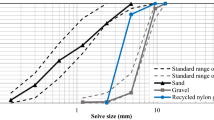Abstract
Pearl-Chain Bridges are an innovative precast arch bridge technology which can utilize pervious concrete as fill material. The present study investigates how the mix design of the pervious concrete fill can be influenced by use of an air-entraining admixture, a high-range water reducing admixture, fibers, and by internal curing using lightweight aggregate to best possibly meet the requirements for a fill material in Pearl-Chain Bridges. The 28-day compressive strength, splitting tensile strength, shear strength, permeability, and freeze-thaw durability were determined and compared for eight different mixture proportions using two different sizes of granite coarse aggregate and at two different water-to-cement ratios. The specimens had an average void content of 24–28 %. Specimens containing air entraining and high-range water reducing admixtures were most workable, as determined by fresh density, and thus the easiest to place. The addition of a high-range water reducing admixture and lightweight sand (expanded shale) for internal curing improved the 28-day compressive strength and splitting tensile strength. The coarse aggregate gradation had a large influence on permeability; however, all tested permeabilities were high enough to drain the rain from a 100-year rain event in Denmark. The air entraining agent dosage used was not sufficiently high to create the necessary protective air content in the cement paste, and the freeze-thaw durability of the specimens were generally poor for the utilized test procedure; however, the mix design containing lightweight sand showed improved freeze-thaw durability compared to the other mix designs.









Similar content being viewed by others
References
Hertz KD (2015) Super-light SL-Deck elements with fixed end connections. In: Proceedings of fib symposium May 18–20, Copenhagen, pp 465–466
Hertz KD, Castberg A, Christensen J (2014) Super-light concrete decks for building floor slabs. Struct Concr J 15:522–529
Halding PS, Hertz KD, Schmidt JW (2015b) Precast Pearl-Chain concrete arch bridges. J Eng Struct 103:214–227
Lund MSM, Hansen KK, Truelsen R, Johansen L (2016) Pervious concrete fill in Pearl-Chain Bridges: using small-scale results in full-scale implementation. Constr Build Mater 106:404–414
IDA Wastewater Commission. Regional variation of extreme rain in Denmark—a new analysis, 1979–2005. Pamphlet No. 28. The Commission, Copenhagen (2006). ISBN: 87-7923-502-6. Danish
Tennis PD, Leming ML, Akers DJ (2004) Pervious concrete pavements. EB302.02, Portland Cement Association, Skokie. National Ready Mixed Concrete Association, Silver Spring
Schaefer VR, Wang K, Suleiman MT, Kevern JT (2006) Mix design development for pervious concrete in cold weather climates. National Concrete Pavement Technology Center and Iowa State University, Ames
Kevern JT, Schaefer VR, Wang K, Suleiman ST (2008) Pervious concrete mixture proportions for improved freeze-thaw durability. J ASTM Int 5(2):1–12
Kevern JT (2013) Reducing the curing requirements of pervious concrete using prewetted lightweight aggregate for internal curing [Internet]. University of Missouri-Kansas City, Kansas City. http://www.escsi.org/uploadedFiles/Technical_Docs/Internal_Curing/Pervious20Report20-20Kevern
Kevern JT, Biddle D, Cao Q (2015) Effect of macro-synthetic fibers on pervious concrete properties. J Mater Civil Eng 27(9):119–134. doi:10.1061/(ASCE)MT.1943-5533.0001213
National Ready Mixed Concrete Association (NRMCA). Freeze-thaw resistance of pervious concrete. NRMCA, Silver Spring (2004)
ASTM Standard C666/C666M-03. Standard test method for resistance of concrete to rapid freezing and thawing. ASTM International, West Conshohocken (2008). doi:10.1520/C0666_C0666M-03R08
Henderson V, Tighe S (2012) Evaluation of pervious concrete pavement performance in cold weather climates. Int J Pavement Eng. 13(3):197–208. doi:10.1080/10298436.2011.572970
ASTM Standard C150/C150M-12. Standard specification for portland cement. ASTM International, West Conshohocken (2012). doi:10.1520/C0150_C0150M-12
ASTM Standard C618-12a. Standard specification for coal fly ash and raw or calcined natural pozzolan for use in concrete. ASTM International, West Conshohocken (2012). doi:10.1520/C061812a
ASTM Standard C311/C311-13. Standard test methods for sampling and testing fly ash or natural pozzolans for use in portland-cement concrete. ASTM International, West Conshohocken (2014). doi:10.1520/C0311-13
ASTM Standard C136-06. Standard test method for sieve analysis of fine and coarse aggregate. ASTM International, West Conshohocken (2006). doi:10.1520/C0136-06
ASTM Standard C29/C29M-09. Standard test method for bulk density (“unit weight”) and voids in aggregate. ASTM International, West Conshohocken (2009). doi:10.1520/C0029_C0029M-09
ASTM Standard C1761/C1761M-13b. Standard specification for lightweight aggregate for internal curing of concrete. ASTM International, West Conshohocken (2013). doi:10.1520/C1761_C1761M-13b
ASTM Standard C192/C192M-14. Standard practice for making and curing concrete test specimens in the laboratory. ASTM International, West Conshohocken (2014). doi:10.1520/C0192_C0192M-14
ASTM Standard C1688/C1688M-13. Standard test method for density and void content of freshly mixed pervious concrete. ASTM International, West Conshohocken (2013). doi:10.1520/C1688_C1688M-13
ASTM Standard C1754-12. Standard test method for density and void content of hardened pervious concrete. ASTM International, West Conshohocken (2012). doi:10.1520/C1754_C1754M-12
ASTM Standard C39/C39M-14a. Standard test method for compressive strength of cylindrical concrete specimens. ASTM International, West Conshohocken (2014). doi:10.1520/C0039_C0039M-14A
ASTM Standard C496/C496M-11. Standard test method for splitting tensile strength of cylindrical concrete specimens. ASTM International, West Conshohocken (2011). doi:10.1520/C0469_C0469M-14
Test Method No. Iowa 406-C: method of test for determining the shearing strength of bonded concrete. Lowa Department of Transportation, Des Moines (2000)
Kevern JT, Wang K, Schaefer VR (2010) Effect of coarse aggregate on the freeze-thaw durability of pervious concrete. J ASTM Int 22(2):469–475
Shu X, Huang B, Wu H, Dong Q, Burdette AG (2011) Performance comparison of laboratory and field produced pervious concrete mixtures. Constr Build Mater 25:3187–3192
Author information
Authors and Affiliations
Corresponding author
Rights and permissions
About this article
Cite this article
Lund, M.S.M., Kevern, J.T., Schaefer, V.R. et al. Mix design for improved strength and freeze-thaw durability of pervious concrete fill in Pearl-Chain Bridges. Mater Struct 50, 42 (2017). https://doi.org/10.1617/s11527-016-0907-4
Received:
Accepted:
Published:
DOI: https://doi.org/10.1617/s11527-016-0907-4




